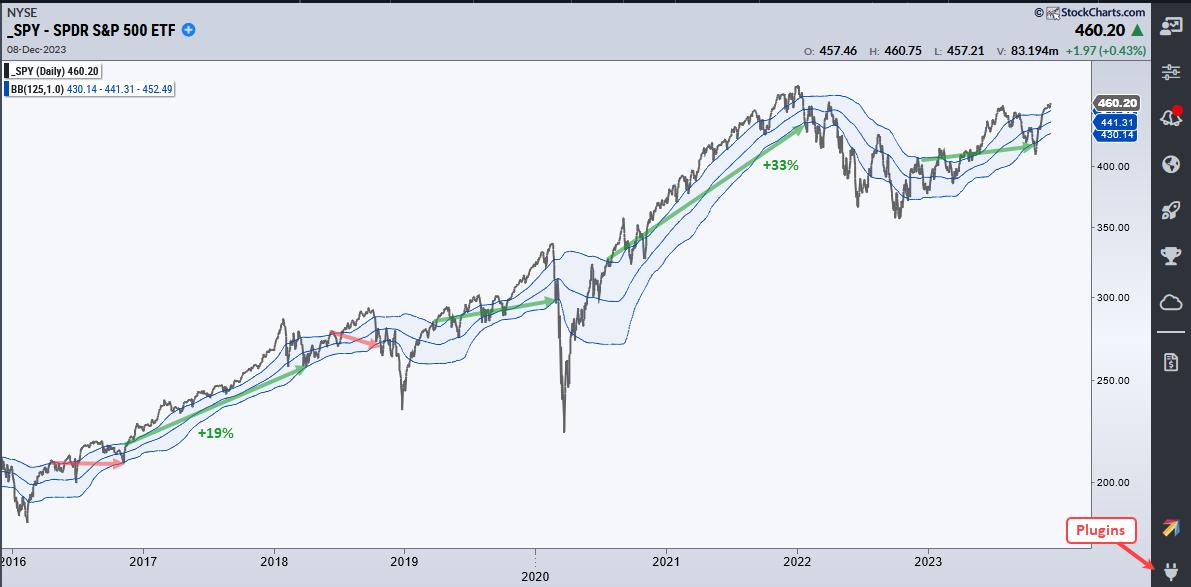 The S&P 500 SPDR (SPY) surged over 10% since late October and exceeded the upper Bollinger Band (125,1). This means price is more than 1 standard deviation above the 125-day SMA. Surely, this means SPY is overbought. But is this actually bearish? Historical evidence suggests that this is more bullish than bearish.
The S&P 500 SPDR (SPY) surged over 10% since late October and exceeded the upper Bollinger Band (125,1). This means price is more than 1 standard deviation above the 125-day SMA. Surely, this means SPY is overbought. But is this actually bearish? Historical evidence suggests that this is more bullish than bearish.
The chart below shows Bollinger Bands(125,1). The middle line is a 125-day SMA and the outer bands are 1 standard deviation above and below this line. 125 days represents around six months so I consider this a trend indicator. A move above the upper band reflects an outsized advance that can signal the start of an extended uptrend. Note that I am only interested in bullish signals here.

As with all trend-following indicators, these signals have their fair share of whipsaws, but they also catch some pretty good trends. The chart below shows the last six signals with four leading to profits (green arrow-lines) and two resulting in losses (red arrow-lines). The two losses were relatively small (-.40% and -3.80%). Two of the four profits were also small (~2%). The bull run through 2017 generated a 19% profit, while the bull run through 2021 returned 33%. In his book, Bollinger on Bollinger Bands, John Bollinger discusses how prices can walk the band during strong trends. Notice how SPY walked the upper band during the strong uptrends in 2017 and 2021. These two big trends more than paid for the whipsaws.
Eight years is not very long so I went back to 1994 and tested this signal over the last thirty years. The table below shows results versus buy-and-hold for SPY. The Bollinger Bands signals produced a lower Compound Annual Return (6.7% vs 7.9%), but the Average Drawdown was much less (17.13% vs 37%). Avoiding big drawdowns is important. We can also see a 66% Win Rate and the Average Gain (14.3%) is more than three times the average loss (-3.80%).

Bollinger Bands (125,1) are solid trend-following indicators. These work well for uptrends, but not so good for downtrends because the stock market has a long-term upward bias. Indicators are not perfect, but the recent move above the upper band is more bullish than bearish. A close below the lower band would to negate this signal.
Momentum-Rotation strategies focus on leaders and often enter positions after price becomes overbought. This is simply the nature of upside momentum. TrendInvestorPro runs momentum-rotation strategies that trade stocks in the S&P 500 and Nasdaq 100. These strategies activated recently as our market timing model turned bullish. Click here to get immediate access and learn more.
Recent Reports at TrendInvestorPro:
- The Essential Breadth Indicator ChartList (with report and video)
- Building a Strategy around the Zweig Breadth Thrust
- Momentum Rotation Strategy for NDX and SPX Stocks
- Mean-Reversion Strategy for Russell 1000 Stocks
Bollinger Bands (125,1) are part of the Trend Composite, which aggregate trend siganls in five trend-following indicators. This indicator is one of 11 indicators in the TIP Indicator Edge for StockCharts ACP. Click here to take your analysis process to the next level.
//////////////////////////////////////////////////
Choose a Strategy, Develop a Plan and Follow a Process
Arthur Hill, CMT
Chief Technical Strategist, TrendInvestorPro.com
Author, Define the Trend and Trade the Trend
Want to stay up to date with Arthur's latest market insights?
– Follow @ArthurHill on Twitter






